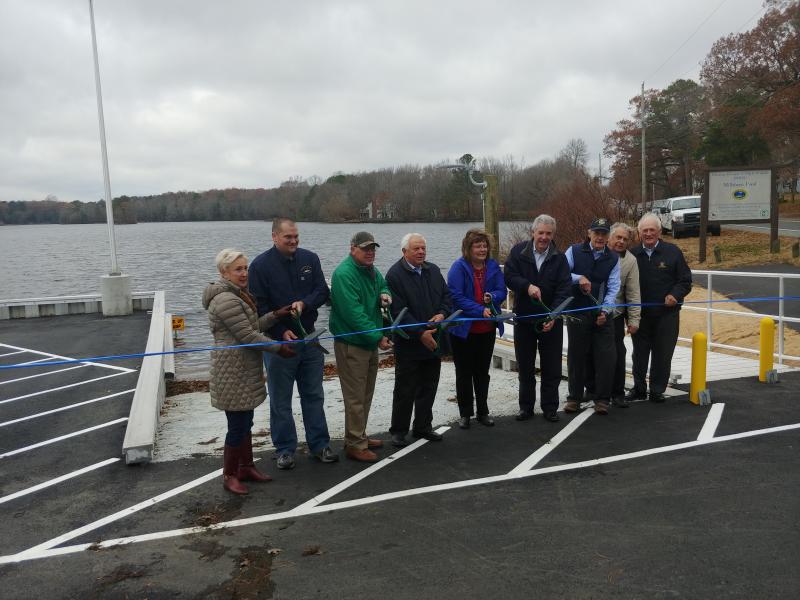Millsboro Boat Ramp is open

It’s official, the Millsboro Boat Ramp was opened Dec. 2, under cold and cloudy skies with a hard northwest wind that had the people in attendance thankful for politicians who made short speeches. Department of Natural Resources and Environmental Control Secretary Shawn Garvin hosted the event and several local politicians spoke of the cooperation between the town of Millsboro, who owns the pond, and the DNREC Fish and Wildlife Division, who maintains the pond, to accomplish this project.
Garvin spoke about the cost of the boat ramp, $625,000, of which 75 percent was paid for with excise tax from fishing tackle and 25 percent paid for by Delaware’s general fishing license. In other words, the entire cost was paid by fishermen. This is true for most of the fishing-related projects in Delaware. No public tax money is used. We pay our own way.
The new ramp has a courtesy dock, new parking spaces and lighting. It is also handicap accessible.
Spot and croaker regulations
The Atlantic States Marine Fisheries Commission is planning to issue a management plan for spot and croaker. Right now, it is in the planning stage with several options floating around. It appears that bag limits will be the most likely management tool.
Spot and croaker have a history of abundance and depletion cycles. A few years ago, there were big croakers in the Lewes-Rehoboth Canal as well as on the reef sites in Delaware Bay. This year, it was spot everywhere and very few small croakers.
I am not sure that management measures can smooth out the up-and-down cycles of spot and croaker. I have no problem with putting reasonable bag limits on these fish, but then you get into what is a reasonable bag limit?
If you can go fishing whenever you want, a 10-fish limit is reasonable. If you can only fish once a year, then a 50-fish bag limit is reasonable. Head boats are not going to be happy with a low bag limit since their customers are, for the most part, meat fishermen. Not many charter boats sail for spot and croaker, but when they do, they won’t want a low bag limit.
The option I read does take into account bait fish. It is a bit complicated. If the bag limit is 30 fish per person, a charter boat can have eight times as many spot or croaker on board once the six-man party arrives. If the boat has a captain and mate, they would only be allowed to have 60 spot or croaker before boarding their party. No more filling the live wells the day before the trip. In the options I read, no mention was made of tackle shops or live bait dealers. This is something that will have to be addressed before the regulations go into effect.
Fishing report
Fishing has been pretty good for those willing to run far enough offshore to find black sea bass and porgies. The Morning Star out of Ocean City had several limits of sea bass and almost 100 porgies on its last trip.
Porgies were once a staple of Delaware fishing. I can recall my grandfather coming home with lard cans full of these fish from trips out of Mispillion Inlet in the late 1940s. By the time I was old enough to fish with him from Slaughter Beach in the 1950s, we caught nice croaker and a few tiderunner trout, but no porgies.
In the past two years, I have seen more porgies in my reports than I have seen in the preceding 60 years. I must assume their range is expanding and they are once again coming close enough to Delaware for our fishermen to catch them.
I believe we would catch more if we rigged up for porgies. Most are caught as bycatch in the sea bass fishery. Sea bass have a large mouth and suck bait in with a big gulp. Porgies are nibblers and require a smaller hook. According to my porgy-catching friends in New Jersey, a No. 1 beak style hook with a red bead is the key to porgy-catching success.
Tog fishing has been good one day and poor the next. Why? I have no idea. The fish are there, but they will bite and then they won’t. I do know a hard-running current will send them into their favorite hidey hole. They will wait there until the current slacks then come out to feed.
Indian River Inlet has suffered the same up and down tog fishing as the ocean and bay. There have been on and off runs of resident rockfish caught on white bucktails with white worms. A few larger rock have been taken by hardy jetty jockeys using live eels.




















































